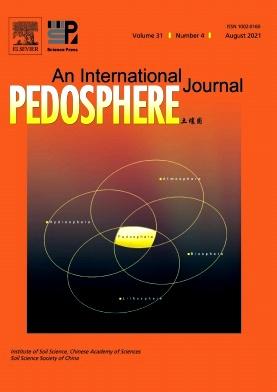亚热带沿海湿地土壤微生物多样性、复杂性和群落组合的季节性模式
IF 7.3
2区 农林科学
Q1 SOIL SCIENCE
引用次数: 0
摘要
土壤微生物群对生物多样性具有重要意义,对生态系统功能至关重要,对各种生物的健康至关重要。然而,季节和植物种类的变化对土壤微生物多样性和群落组合的影响仍然知之甚少。研究了互花米草入侵和马勒塞草(Cyperus malaccensis)和倒伏坎德尔(Kandelia obovata)恢复对滨海湿地夏季和冬季土壤细菌、真菌和原生生物群落的影响。结果表明,冬季土壤细菌、真菌和原生生物多样性分别比夏季高2.63%、40.3%和9.90%。植物物种对微生物多样性有明显的影响。值得注意的是,与互花葡萄球菌入侵相比,倒卵蛙恢复显著增加了细菌多样性,但降低了原生生物多样性,对真菌多样性没有影响。季节和植物种类对细菌、真菌和原生生物的群落结构均有显著影响。但与细菌和真菌群落结构相比,原生生物群落结构对季节更为敏感。细菌、真菌和原生生物内部或之间共生网络的复杂性在冬季高于夏季。细菌和原生生物群落的组装主要受随机过程驱动,而真菌的组装主要受确定性过程驱动。与夏季相比,冬季细菌和原生生物群落聚集的随机性较低,表明冬季群落聚集更具确定性。我们的研究结果强调了季节和植物物种在调节微生物群落中的关键作用,揭示了与夏季相比,亚热带沿海湿地冬季微生物多样性、网络复杂性和群落聚集的确定性更高。本文章由计算机程序翻译,如有差异,请以英文原文为准。
Seasonal patterns in diversity, complexity and community assembly of soil microorganisms in a subtropical coastal wetland
Soil microbiomes are significant for biodiversity, crucial for ecosystem functions, and vital for the health of various organisms. Nevertheless, the impacts of season and plant species shifts on soil microbial diversity and community assembly are still poorly understood. This study explored soil bacterial, fungal, and protistan communities during summer and winter in a coastal wetland affected by Spartina alterniflora invasion and subsequent Cyperus malaccensis or Kandelia obovata restoration. The results showed that bacterial, fungal, and protistan diversity were 2.63%, 40.3%, and 9.90% higher in winter than in summer, respectively. Plant species had a distinct impact on microbial diversity. Notably, K. obovata restoration significantly increased bacterial diversity, but decreased protistan diversity, with no effect on fungal diversity when compared to S. alterniflora invasion. Season and plant species both significantly influenced the community structure of bacteria, fungi, and protists. However, protistan community structure was more sensitive to season compared to the structure of bacterial and fungal communities. The complexity of co-occurrence networks within or among bacteria, fungi, and protists was higher in winter than in summer. Bacterial and protistan community assembly was primarily driven by stochastic processes, while fungal assembly was dominated by deterministic processes. Bacterial and protistan community assembly exhibited lower stochasticity in winter compared to summer, suggesting a more deterministic assembly of communities during winter. Our findings highlight the critical role of season and plant species in regulating microbial communities, revealing higher microbial diversity, network complexity, and determinism in community assembly during winter compared to summer in a subtropical coastal wetland.
求助全文
通过发布文献求助,成功后即可免费获取论文全文。
去求助
来源期刊

Pedosphere
环境科学-土壤科学
CiteScore
11.70
自引率
1.80%
发文量
147
审稿时长
5.0 months
期刊介绍:
PEDOSPHERE—a peer-reviewed international journal published bimonthly in English—welcomes submissions from scientists around the world under a broad scope of topics relevant to timely, high quality original research findings, especially up-to-date achievements and advances in the entire field of soil science studies dealing with environmental science, ecology, agriculture, bioscience, geoscience, forestry, etc. It publishes mainly original research articles as well as some reviews, mini reviews, short communications and special issues.
 求助内容:
求助内容: 应助结果提醒方式:
应助结果提醒方式:


